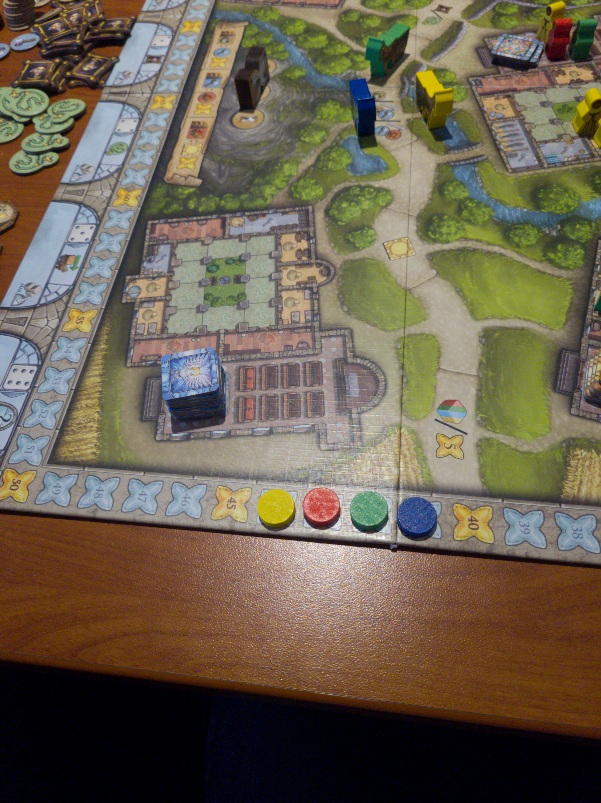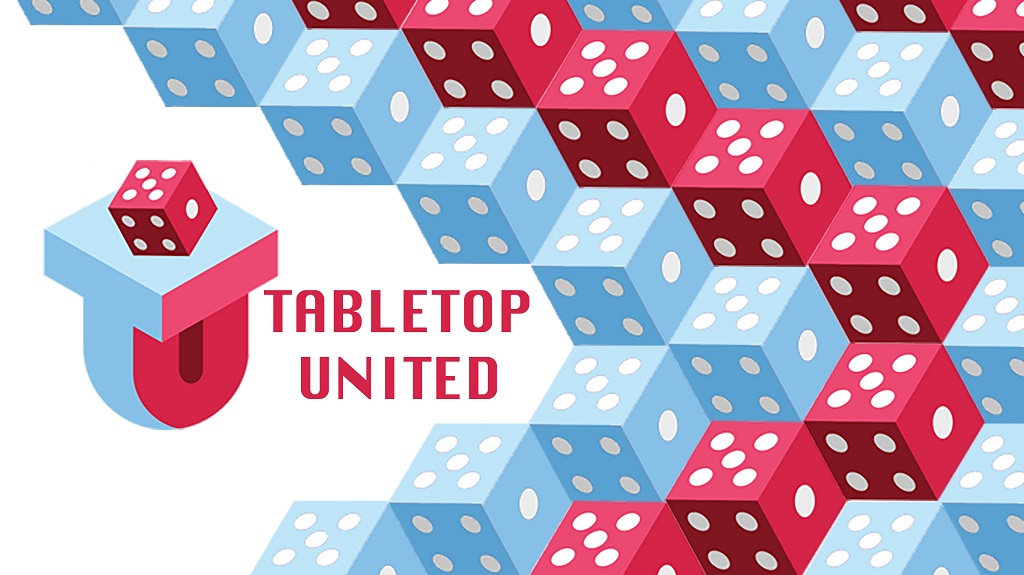Monasterium
Designer: Arve D. Fühler
Artist: Dennis Lohausen
Publisher: dlp games
Year Published: 2020
No. of Players: 2-4
Ages: 12+
Playing Time: 60-120 minutes
Main mechanics / Theme: Dice Drafting, Grid Coverage/Pattern Building, Worker Placement / Religion, Reputation Building
The pastoral world of monastaries, monks, acolytes, novices, chapels, cloisters, stained glass and beer....ah, how cutthroat it can all be!
Find more info on BoardGameGeek.com / Kickstarter
Overview:
From the publisher: In the early Middle Ages – the heyday of ecclesiastical power – no less than five monasteries were built in a beautiful valley, designating themselves to spread the Word of God. As the dean of a cathedral school, you try to accommodate the novices entrusted to you in the monasteries and thus establish a distinguished reputation. You send novices, according to their talents, to the monastery buildings, the chapel or the cloister. In doing so, the advocacy by influential personalities or other monks is not to be underestimated. In addition to this, you can fulfill the special missions of the monasteries and help to build the church window of your cathedral in order to raise the glory of your school even more. After the three-year novitiate, it will turn out who has been able to gain the most fame and honor with his apprentices.
This game really has a lot going on. On your turn, you want to use the dice to do several things:
- Send novices to monasteries. This is how most of your points in the endgame will be scored depending on how many novices you have in each monastery and where in that monastery they are located (chapel, secular buildings, or cloister).
- Gather resources (soup, influence, rosaries). These items are used to pay the associated costs of placing your novices.
- Advance your messenger. This is how you gain access to each of the different monasteries and get bonuses along the path as well as additional personal dice.

Gameplay and Mechanisms:
As I mentioned, in this game you will be using dice in order to be able to do all of the things that you want to do during the game. But how you get these dice is really interesting and unique (at least in my experience). To begin each round, all players will have a set number of neutral dice plus one personal dice of their player color. All players roll their dice simultaneously and, in turn order, select all dice in their pool with a chosen number to put in the indicated pot on the board. Once all players have made a selection, all players with dice remaining reroll their dice and selection begins again with the first or whomever is next in clockwise order with dice remaining. This continues until all dice have been selected. Play then proceeds to the action phase. During the action phase, in turn order, each player may select up to 3 dice from one of the dice pools of a selected number (unless the choose to take a 6 in which case they will only select one die.) If a player selects from a pool where their personal die/dice has been placed, they must select their personal die/dice as part of their selection. That player then carries out the action associated with that number. Play continues around the table until all dice have been selected. 1st player marker then rotates clockwise, all workers and dice are collected and things begin again. The game takes place over a span of three years with each year being marked by each player having been the first player for a round so play time varies quite a bit by player count. In a 2-player game, each year will consist of 2 rounds while in a 4-player game each year will consist of 4 full rounds. As you send your novices (workers) to the different locations in the monasteries, more actions for each dice will be uncovered as well as bonuses such as gaining a point for each die that you select of that particular value. Points and resources can also be gained by collecting stained glass from the different monestaries and filling out the stained glass window of your monastery board. Lastly, there are also communal objectives that gain players points as they are completed throughout the game some of which are more valuable if they are completed in earlier years. It's a complex puzzle to figure out buy very rewarding and satisfying. Our last game that we played was a four player (we only got two years in though) and everybody finished within one point of the spot in front of them so it seems to provide some really tight game play.

Theme, Artwork and Illustration, Graphic Design and Layout
The artwork is solid and really evokes the monastery theme. Everything works, the board is clean and not muddled. One thing that I would mention (and I was only provided a review copy so things may not be final) is that some of the slots on the player boards are too tight for the tokens. The dice value tokens are meant to be flipped over to indicate when the +1 point has been unlocked and they are tight to the point that you risk shaking up your entire setup trying to get them flipped. Also, the reroll token slot is so tight to the token that I don't know how you would get it back out if you actually pushed it all of the way in. Other than that, the components for this edition are all top notch. I especially love the dual layer boards where the novices reside and the screen printed meeple.

Inclusivity and Accessibility:
Tabletop United believes that diversity is a source of fun and happiness. Nurturing and celebrating our personal differences can lead to amazing gaming (and life) experiences.Therefore, TTU is putting renewed emphasis on inclusivity and accessibility to each of our reviews. This inclusivity and accessibility section will critique those issues and strengths of the subject in the review based upon the unique background of the reviewer. Each reviewer views the world through their own particular lens and has a wide and varied experience from which they will write and review from.
It seems that the designers did try to intentionally add some inclusivity into the game with the screen printed meeples who obviously have differing skintones and their facial and clothing shapes even indicate differing body types which is nice to see. Accessibility may be a little tough as all of the shapes are fairly similar and the color palette of the pieces and personal dice are in primary colors plus green so will be difficult to distinguish for those with color blindness. There is a lot of symbology used in the game that is easy to distinguish so there should be some language independence once players know how to play the game and understand the rules.

What Worked:
I like the mechanisms of the game with the interesting dice draft and player actions. There is a lot of meat on the bone in this one, so decisions feel weighty and important while at the same time, there are some turns where you may be simply gathering resources. Luck plays a factor in this game both in the dice rolls and having dice available that you want to use on your turn, but this can be mitigated a lot by being strategic with which novices you send out to the monasteries thereby opening up more options to use with specific dice. It seems that there are many paths to victory and rewards are there for the taking by going in multiple routes with your strategy. The duel layer boards for the most part (previously mentioned issues aside) are nice and make it easy to keep your pieces in place.

Final Thoughts:
Overal, we really enjoyed this game and look forward to being able to get it to the table again. The tightness of our scores even though we were all focusing on different things is a testament to the flexibility of the gameplay of this one. Focus on getting your novices out, moving your messenger down the line or filling your window and you will reap the rewards in all of those, finding that balace that lets you accomplish some of all of these things can be a challenge, but some challenge is welcome in my gaming group. It's a bit of a heavy game, but certainly not one that wore out its welcome at our table. I would recommend this for those that enjoy medium to heavy weight euro-style games.

Stefan Yates

Stefan Yates is a professional at Kansas State University. Finding ways to work gaming into work, he serves on the university’s Alternate Reality Game Committee and is a co-Faculty Advisor for the Board Game Club. He is also a PhD student whose field of research is Gamification in Student Programming. He enjoys playing (and mostly losing) almost any type of game and likes to work in multiple game sessions per week whenever possible. An avid solo gamer with an additional interest in tabletop miniatures games, the stay-at-home orders of the pandemic were not particularly concerning as there was always painting to do and terrain to build. Stefan is also a book and movie collector and a huge football fan (go CHIEFS!)


